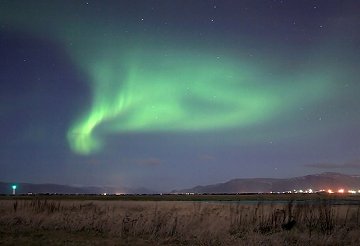 Where's Saturn? Is that a UFO--or the ISS? What's the name of that star? Get the answers from mySKY--a fun new astronomy helper from Meade. Where's Saturn? Is that a UFO--or the ISS? What's the name of that star? Get the answers from mySKY--a fun new astronomy helper from Meade. THANKSGIVING SKIES: Thanksgiving is the biggest travel holiday of the year in the United States. Millions of people board airplanes and fly long hours to visit friends and family. Dreading the trip? Think of it as a sky watching opportunity. There are some things you can see only through the window of an airplane: full story. AURORA WATCH: A solar wind stream hit Earth on Nov. 20th sparking auroras over Scandinavia and Iceland. Fredrik Holm photographed this "green twister" over Reykjavík: 
Photo details: Canon EOS 30D, 200 ISO, 30 seconds
The display has subsided, but perhaps only temporarily. Solar wind is still buffeting Earth's magnetic field and more geomagnetic storms are possible. People at high latitudes should remain alert for auroras. COMET 17P/HOLMES: Exploding Comet Holmes is fading as it expands, and it is no longer easy to see with the naked eye, but it remains a good target for off-the-shelf digital cameras. A ~20 second exposure yields a print like this: 
"After midnight the sky cleared up and the comet was an easy target in my suburban sky even without a telescope," says photographer Peter von Bagh of Porvoo, Finland. Comet Holmes is now about as wide as a full Moon with a vast atmosphere that overlaps the bright star Mirfak. It's a beautiful ensemble for cameras and backyard telescopes alike. Take a look tonight after sunset: sky map. Comet 17P/Holmes Photo Gallery
[Interactive World Map of Comet Photos]
[sky map] [ephemeris] [3D orbit] [Night Sky Cameras] | 
